Zero Motorcycles' Electric ADV Bike Stakes Claim in Motorcycling's Fastest-Growing Segment

Zero Motorcycles enters the fastest-growing segment of motorcycling with its new go-anywhere, do-anything DSR/X.
With a claimed range of +/-150 miles and a ride time of at least 10 hours, the new bike offers the company's strongest motor and most powerful battery.
Riding an electric motorcycle on dirt takes a fun, adventurous activity to an entirely new—and silent—level.
Electric motorcycles have come a long way since Zero Motorcycles was founded in 2006. With the release of the world's first production electric adventure bike, the California electric vehicle pioneer is taking electric bikes where few have gone before. The 2023 Zero DSR/X is a trail-chewing, rock-scrambling, hill-climbing beast of a full-sized ADV bike—and all the while, the only thing you hear is a wash of gravel and dirt spraying out behind you.
Developed from the same basic frame as the company's popular SR/F and SR/S street bikes, the DSR/X reinforces the platform, boosts battery capacity and torque, and adds a slew of off-road-ready features and necessities.
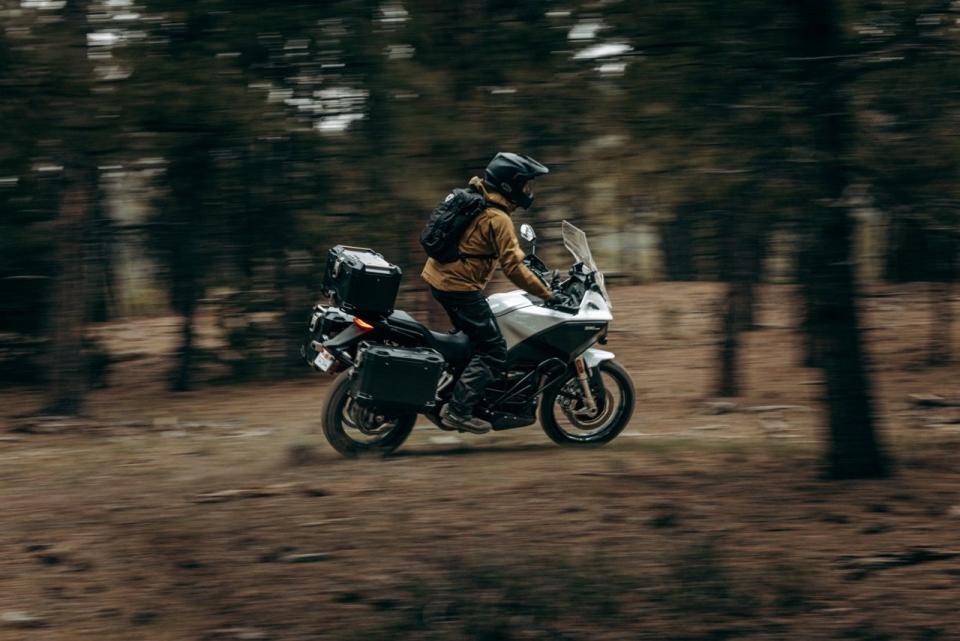
No one who's ever ridden an electric motorcycle can deny these bikes have the potential, power, and torque to conquer the trails. But can the Zero DSR/X provide the mileage range dual-sport bikes require, and the extended ride time ADV riders crave?
At a recent press event in Park City, Utah, Autoweek got to put the new adventure bike through its paces, on both trails and pavement. Here's what we found.
A Worthy ADV Adversary
All riders know that motorcycling is a transformative experience—it's like detox for our brain. But riding in the wilderness, away from traffic and alone in nature, brings out a self-reliant pioneer spirit no highway can provide. Riding an electric bike on the trails, however, is another matter altogether: a purifying sensation that makes motorcycling, and off-road riding in particular, even more immediate and palpable.
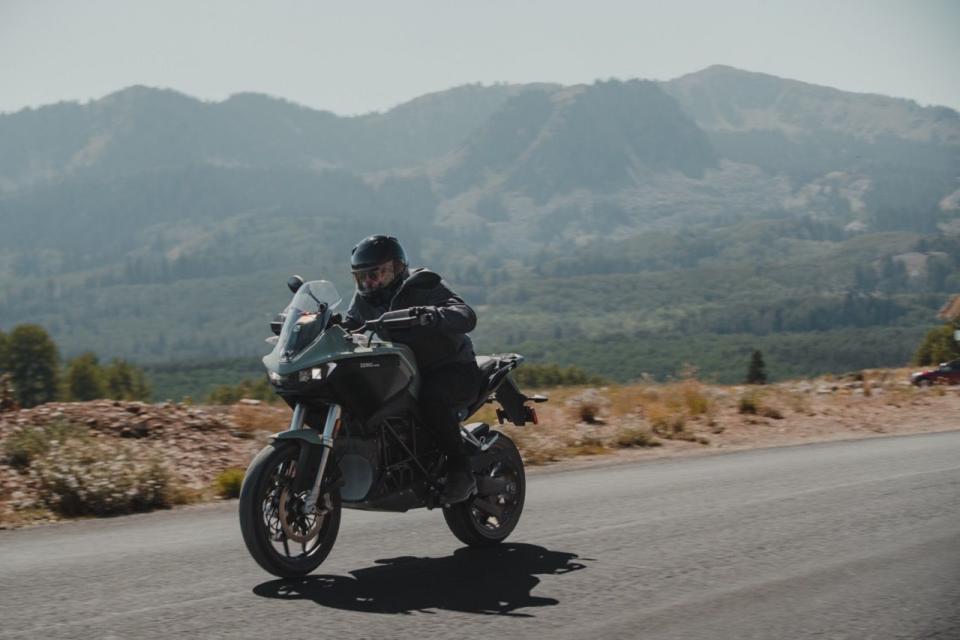
On an electric bike, the only sounds are that of the natural world around you and your tires spinning on dirt (or sand, or mud, or ... ) and the breeze rushing past your helmet. Even while tearing up well-trod fire trails you can still hear the call of birds in the trees and the rush of water from an adjacent stream. Rather than your exhaust peal sending animals scurrying before you get anywhere near them, the silence of your electric ADV motorcycle lets you ride right by wildlife without disturbing it (too much). We also appreciate the environmental aspects of zero noise or emissions pollution.
Another point worth making: Shifting while standing can be tricky for even the most skilled rider. If the key to riding on dirt is to stand on the foot pegs to lower your center of gravity, then this Zero would make a good starter ADV bike for an experienced street rider with limited off-road experience. I've ridden most everything on pavement, but to be able to stand, twist, and tear up the trails without having to use my fingers and toes on the controls made the dirt riding experience far easier than it's ever been.
Powered by a new motor that cranks out a trail-shredding 166 lb-ft of torque, the new DSR/X makes full use of Zero's industry-leading tech—plus an integral partnership with Bosch—to create a full-size ADV bike whose profile stands shoulder-to-shoulder with dual-sport competition such as the Harley-Davidson Pan America, BMW's GSs, and the Ducati Multistrada.
At the curb, anyway. But can the DSR/X hang with those stalwarts on the spec sheet, let alone on the roads and trails? Stylistically, the Zero's fairing and exposed trellis frame certainly bring the Multi to mind, if not the Pan Am. From the saddle, the bike's power and performance are definitely comparable. As long as the battery can keep up with the range of those fuel tanks, the DSR/X will be a worthy adversary in ability and versatility.
But will that battery continue to deliver long after the pavement runs out? We're always leery of manufacturer claims, so let's dig deeper. The bike's ZF75-10 motor was modified with an extra spin of its copper windings, adding about 20% more torque over that of the SR/F and S while reducing its top speed from 124 mph to around 112 mph. According to the bike's spec sheet, the Z-Force 17.3-kWh battery pack offers a 180-mile range in the city and 85 miles at highway speeds, for a median range of around 115 miles.
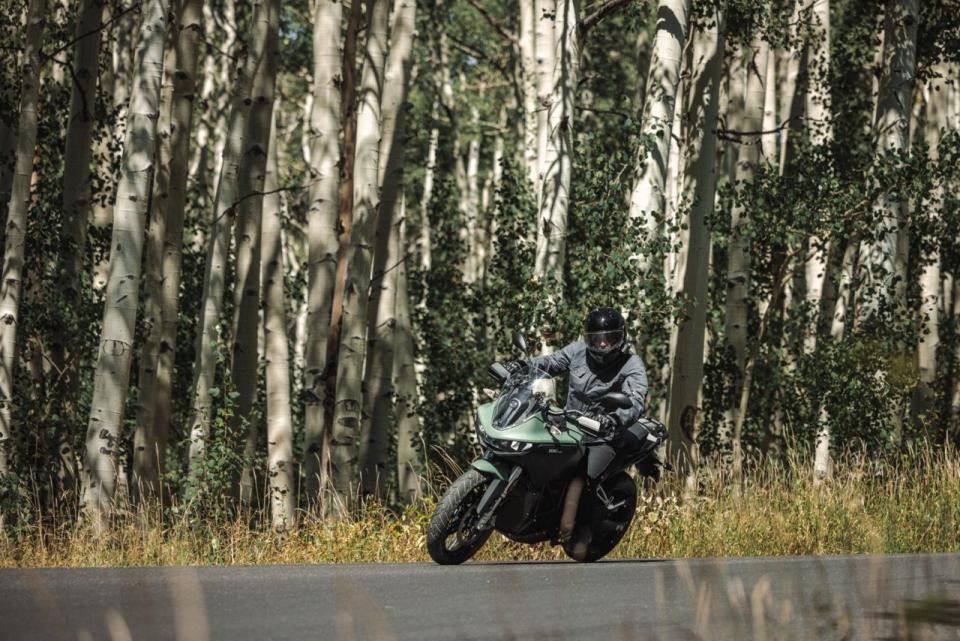
Unfortunately, there's no accepted standard for measuring off-road range. No slouch in the saddle himself, Zero Chief Technical Officer Abe Askenazi told me that trail riding actually uses less battery power than highway riding because the typical ADV rider rarely has the throttle open even halfway. Despite the increased torque required in ADV riding, a gentler throttle means less battery power used, translating to a longer mileage range.
Pointing to internal research that shows the average ADV rider stays around 15-25 mph on trails, Askenazi said the company's own testing at those speeds showed the DSR/X should provide a trail range of about 150-175 miles, offering anywhere from 10-15 hours of riding time—depending, of course, on how fast and how aggressively one rides.
Despite Zero's confidence, however, we're not positive we'd take that chance out in the wild. Backcountry Discovery Routes (BDR), the nation's leading ADV advocacy group that's mapped out trails for motorcyclists all over the US, allows users to select a "Charging Station" map layer to locate Level 2 EV chargers all along its routes. Indeed, a quick zoom into the BDR map shows EV chargers scattered all over its Colorado route, from New Mexico to Wyoming.
A BDR rep told us this initiative of mapping off-road EV charging stations is a focus for the non-profit group in the immediate future, and it's currently working with several electric vehicle manufacturers (including Zero Motorcycles) to update all its maps with this Charging Station layer.
Look, if you run out of gas there's no one to blame but yourself, right? Same holds true for battery juice. If you're taking any electric ADV bike onto the trails, we highly recommend utilizing Backcountry Discovery Routes and its Charging Stations map layer.
Runnin' With the Devil
The Zero Motorcycles DSR/X runs the company's proprietary Cypher III+ operating system, and functions such as charging status and tip-over events can be monitored via the app. It also makes full use of Bosch's advanced Motorcycle Stability Controls (MSC) for better braking and stability. The MSC integrates with the bike's linked braking system, which distributes stopping power to both wheels if a rider relies too heavily on either brake. If you think that's important on the street, it's critical on the trails. MSC also provides the DSR/X super-handy Hold function that keeps both wheels locked for three minutes, or until it detects any input on the hand or foot controls. Like a temporary parking brake, it's especially handy at hilly stoplights.

Even handier is the bike's Park mode, which provides torque- and speed-controlled forward and reverse gears to make putting the sidestand down on a 544-pound bike a breeze no matter where you are. We've used this function while moving big touring bikes around garages and parking lots, but to use it on a dirt incline, with loose gravel and stones under our boots, was a revelation.
Zero has increased the number of ride modes to five on the DSR/X by offering a new Canyon mode. It also added an Off-Road setting, controlling both traction control and ABS, that's useable for each mode. Easily switchable via the left handgrip, these settings allow you to dial in your ride whether you're on pavement or not, and to break the rear wheel loose and slide around turns on dirt. Ride-by-wire, indeed.
Like the rest of its model lineup, but unlike most ICE off-road bikes, the Zero DSR/X utilizes a belt drive rather than a chain. The width of the Gates Carbon Drive belt was increased from 20mm to 25mm and uses a stronger core; it's twice as strong as the belt found on Zero's SR/F and SR/S. The drive also uses Gates's innovative MudPort sprockets, which allow mud, dirt, sand, and even snow to escape the belt and gears rather than muck up the transfer case.
The inverted Showa front fork provides eight inches of travel, while the rear monoshock offers a hand-adjusted preload for customization when you're carrying luggage or a passenger. Both on the road and on the dirt, the suspension on the DSR/X was smooth and responsive, and braking was exemplary.
Rider position is active and ready but upright and comfortable; moreover, the saddle is plush and the reach to the grips easy. The standard seat height is 32.6 inches, but optional Tall and Short saddles allow for ergonomic customization. The windscreen adjusts easily right from the saddle with two simple crank knobs on either side. Taller and long-range riders may choose to opt for the tall accessory windshield; for me, the standard screen pushed the wind over my 5-foot-11 frame perfectly.
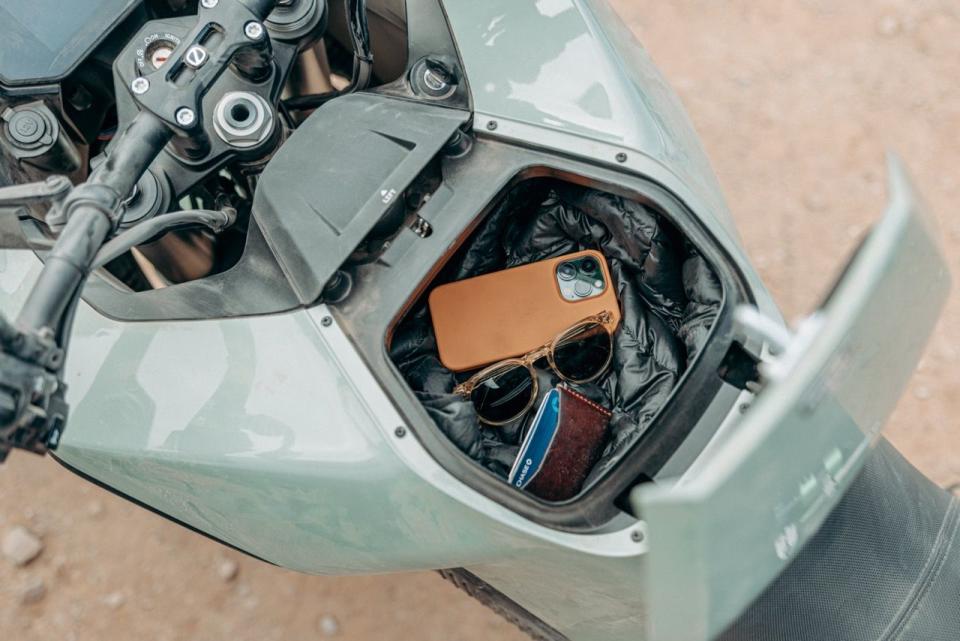
Three storage compartments offer a claimed 7.4 gallons of onboard storage, most of it under the “fuel tank”—a deep cubby that's not quite spacious enough to fit a helmet. There's another small storage compartment under the seat for important papers and the like, and a slightly larger one behind the right front fairing for toolkits and such; it's secured with Torx bolts. All are waterproof. Cruise control is standard, as are heated grips and handguards. If you want more, the Zero accessory catalog offers plentiful options for the DSR/X, from luggage and controls to power-ups.
The Zero DSR/X is equipped with what the company claims are the fastest Level 1 and Level 2 charge capabilities in the market, thanks to the onboard 6.6-kW Rapid Charge system. Owners can opt for a Power Tank to increase the battery capacity to nearly 21 kWh, or an additional Rapid Charge Module that will double the charging speed and reduce the minimum charge time to just one hour. Unfortunately, that under-tank storage compartment is the only place on the bike either of these power accessories can go, and you can't add both in tandem. So choose your fighter: longer ride range or faster charge time.
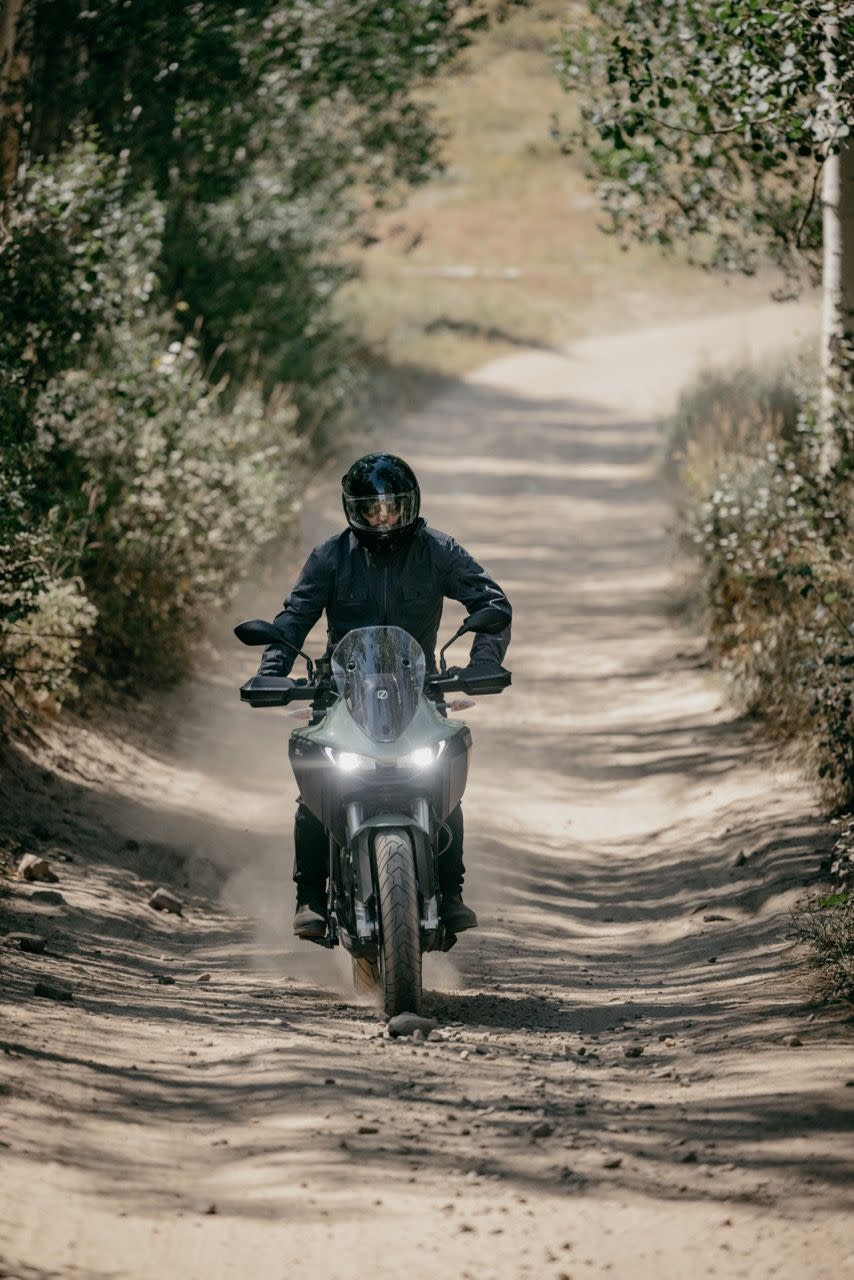
Ready for ADV Prime Time?
After our daylong ride in and around the roads and fire trails of Park City, I think Zero has a hit on its hands. The DSR/X moved like a gazelle on the twisties and tackled the dirt and moguls with aplomb, the whole time staying quiet, comfortable, and responsive. I mentioned Ducati's Multistrada earlier, and after spending the day aboard the Zero DSR/X, that comparison seems the most apt. The two bikes are not only similar in size and style, but the ride is comparable, too. Except without all the noise and that annoying shifting. (Relax, Ducatisti—that's a quip.)
Rolling silently through the wilderness with Coltrane in my helmet speakers was a pleasure cruise, indeed. And when I felt like cutting loose? The DSR/X was right there with me, rarin' to go.
So is the Zero DSR/X worth the $25k sticker price? If you're an experienced ADV rider who's looking for a change of pace or is concerned about the environment, the answer is most definitely yes. It's as strong and nimble as any of the competition, charging be damned. While the proximity of Level 2 stations and mileage range will certainly add anxiety off-road, the benefits of riding silently in the wild, far from pavement and traffic and among the birds and the trees, should go far to allay those concerns. As you would with any ride, just be prepared before you head out.
Part of Zero's 2023 model year lineup, the Zero DSR/X is available in Sage Green or White Pearl, and should be on showroom floors by early October.
Spec Sheet
MSRP
$24,495
CITY RANGE
180 miles (290 km)
HIGHWAY RANGE
85 miles (137 km)
COMBINED RANGE
115 miles (185 km)
PEAK TORQUE
166 lb-ft (225 Nm)
PEAK POWER
100 hp (75 kW) @ 3650 rpm
TOP SPEED
112 mph (180 km/h)
POWER PACK MAX CAPACITY
17.3 kWh–20.9 kWh
TYPICAL COST TO RECHARGE
$1.94
LEVEL 1 CHARGE TIME, TO 95%
10.0 hr
LEVEL 2 CHARGE TIME, TO 95%
2.0 hr
6-KW RAPID CHARGE TIME, TO 95%
1.0 hr
WEIGHT
544 lbs (247 kg)
SEAT HEIGHT
32.6 inches (828 mm)
POWER PACK WARRANTY
5 years/ unlimited miles

 Yahoo Autos
Yahoo Autos 